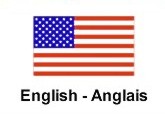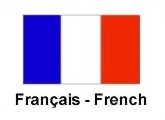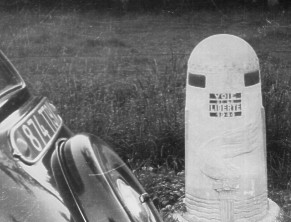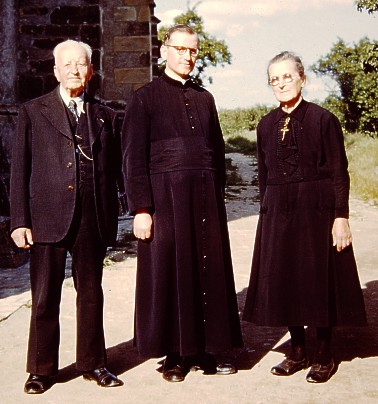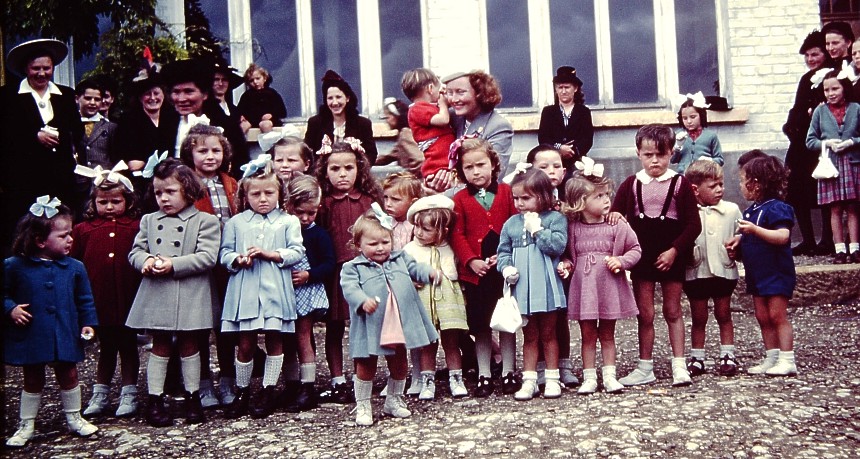Visitors in Fèves!
June 3, 1949, would be an important day! While there had been many connections between Morganville and Fèves - those made
by letters, radio broadcasts, packages sent as aid and the visits of Todd and de Wendel - all felt a bit second-hand. But on
this day, one of Morganville's own would visit the adopted village.
The day began with Billie and Ed Utley leaving their home in Fontenay-aux-Roses, a southwestern suburb of Paris. They picked up
translator Yvonne Bazin and husband Leon "Jean" Bazin at her office near the Champs-Élysées in the heart of the city.
From there, they began a journey eastward through Épernay - the heart of the champagne region - and on to Verdun.
The couples visited the battlefield monuments from World War I northeast of the city.
While traveling to Fèves, they passed many stone markers on the Voie de la Liberté - Liberty Road.
After World War II, the French wanted to show their gratitude to the young Americans who had helped liberate France. A
single monument was thought not to be enough. General George Patton's French liaison, Guy de la Vasselais, suggested a
"borne" - a stone marker - be placed every kilometer along the route Patton's army had traveled.
Ed Utley's photo of a borne
The entire trip today from Paris to Fèves would be about 200 miles and would take about three hours. But four years after the war, many roads were narrow with potholes. A trip of 200 to 300 miles was considered a long day. With the Utleys and Bazins adding a bit of sightseeing, it is not surprising that Billie reported they arrived at Fèves about 4 p.m.
In his December 1948 letter reporting on his visit, Todd had written, "Fèves is one long street on the side of a hill."
While it was somewhat more, it wasn't much more.
No record was made noting from which direction the Utleys entered the village, but the most direct route would have been
from the west, past the cemetery. Billie reported, "Mr. Torlotting and his wife met us on our arrival."
There may have been some missed communications, for it was discovered they had been expected for lunch.
The village limits of Fèves in 1948 are indicated by the red lines on the roads of this
present-day satellite image. One building served as the school, village hall and teacher Torlotting's home.
Billie described the Torlotting home as follows:
The schoolmaster's home is combined with the schoolroom and town hall. To the back of the home is a courtyard where the children play on school days and one corner is occupied by Mr. Torlotting's chickens. Beyond the courtyard is Torlotting's well-kept garden, about one acre. From the balcony of their home one has a fine view of the Moselle valley, Fort St. Quentin, Metz, and to the left the industrial village of Maizieres.
The photo with the school children on Page 6 is of the back of the building Utley described. Inspection of that image reveals a balcony above the school windows containing some potted trees. That balcony was one of the first places the Utleys met some of the residents of Fèves.
Standing, left to right: Marie (Mrs. Henri) Girard, priest Louis Holveck, mayor Auguste Berne, Mathilde (Mrs. Henri) Torlotting, Henri Girard, Marie (Mrs. Auguste) Berne, Emile Pierson, Marcelle (Mrs. Emile) Pierson, Billie Utley; kneeling: schoolmaster Henri Torlotting, Yvonne Bazin, Yvonne's husband Leon "Jean" Bazin, and Ed Utley. Emile Pierson was the first deputy mayor and the Girards were close friends of the Torlottings.
After meeting with some of the townspeople at the Torlotting home, the Utleys and Bazins walked up the hill to the north and
visited the parsonage. There they were "served the largest strawberries we have ever seen" along with cake.
The four then toured the old church. Most of the damage from the war had been repaired. They were told the stained-glass windows
had been stored in the basement of the church and so they had not been damaged.
The townspeople had acquired some livestock before the Utley visit. Billie reported, "The cattle were being
brought from the fields at this time. There are 80 head of Holsteins, all in fine shape," adding that the experience
made her feel, "much at home now."
Priest Louis Holveck with his parents. Photo
on south side of the church with
the people
looking into the late afternoon sun
Dinner that evening was at Mr. and Mrs. Emile Pierson's home in the southern portion of the village or "Lower Fèves."
Breakfast the following day was at the Torlotting home.
Torlotting home lunch. (l-r) Billie Utley, Ed Utley,
Marcelle (Mrs. Emile) Pierson,
Mathilde (Mrs. Henri)
Torlotting, Yvonne Bazin and Emile Pierson
After church, the village children, along with many of their mothers, went to the small playground area just south of the schoolroom. The Utleys then distributed the Life Savers candy and other items Carson had sent, as well as some the Utleys had brought with them. Billie said, "the children sang several songs, one of them was Lorraine's national anthem 'Joan of Lorraine' and as they left, they gave us a big 'hip, hip, hurrah' and 'Good bye' in English. Each one shook hands with us. A lovely group of neatly dressed children and so perfectly trained."
The Utleys distributed candy and other items brought for the Fèves children. The small rolls of Life Savers can be seen in the hands of several youngsters. Billie Utley is in the center holding the child with red clothing.
Billie said they were told that while many items could now be obtained, sugar, rice, coffee and baby cereals were
still in short supply. Bed linens were also needed and there was a shortage of clothing for older women, who usually
wore only black. The seeds had apparently been put to good use as the gardens were well kept and there seemed to be a
good supply of fruits and vegetables.
She completed her report of their visit as follows:
During our visit to Feves, we felt so much at home because they are much like the people of Morganville, warm
hearted, interested in their families, their fields and simple lives.
It was hard to say good bye. The Torlottings accompanied us to the top of the hill. It was like parting with our own
people. Their morale is wonderful when one considers what they have been through. They explained we were received as
ambassadors of Morganville and the wonderful reception accorded us were directed to the people of Morganville and not
to us alone. Our next visit to Feves will be as friends. Never doubt their absolute sincerity about friendship of Feves
to Morganville.
